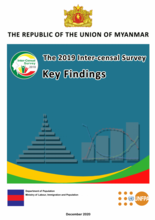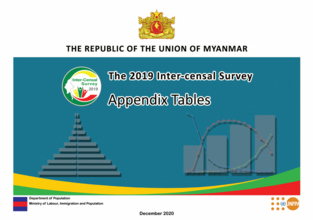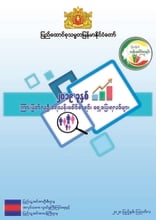YANGON, Myanmar — Almost half of Myanmar’s population is below 25 years of age (46.5 per cent). These 23.4 million children and youth represent the future of the country. Yet a new census report reveals that many of them are growing up in dire conditions that hamper their potential in life:
One in three children live in households that lack access to safe drinking water (34 per cent), to an adequate toilet (31 per cent), and to a TV or radio (37 per cent). Most children (86 per cent) live in households that use solid fuels or kerosene for cooking, putting them at risk of respiratory diseases, poisoning and fire. Only half of 14-15 year olds go to school (51 per cent). One in five children aged 10-17 is working. Almost 1 million children under the age of 15 are growing up without a parent or grandparent (5.2 per cent), and close to 60,000 small children under the age of five live in institutions such as orphanages and monasteries. 72 out of every 1,000 children die before their fifth birthday.
“There is an urgent need to invest in sanitation, education and health in order to create a solid and safe foundation for children and young people, especially in rural areas. Children who get a good start in life in a nurturing home environment are better equipped to become adults that are healthy and happy, and that can contribute to the country’s social and economic development”, says Janet Jackson, UNFPA Representative for Myanmar.
It is particularly important to give targeted support to children and young people who face significant disadvantages. These include children who live in huts and other deficient housing; children who have never attended school; children who are growing up without access to a TV or radio; and children who are living with a disability.
The findings come from the 2014 Myanmar Population and Housing Census Thematic Report on Children and Youth, published by the Ministry of Labour, Immigration and Population and UNFPA. The report shows that only two out of three 11 year olds (68 per cent) have completed primary school. School attendance drops significantly for older children: Only one in three 14 year olds (32 per cent) have completed middle school. And only one in four 18 year olds have completed high school (23.7 per cent).
At the same time, too many girls marry and become mothers at too young an age. Almost 300,000 teenage girls in Myanmar are already married (13 per cent), and 89,000 of these have already given birth.
“The teenage years is a critical time, especially for adolescent girls at risk or early marriage and unintended pregnancy. Young people represent a huge source of potential for Myanmar’s development. Government policy needs to focus on making sure that education – including information about reproductive health – extends to all groups in society so that every young person’s potential is fulfilled, no one is left behind, and the furthest behind are reached”, says Janet Jackson, UNFPA Representative for Myanmar.
The report also confirms the trade-offs that young women in Myanmar have to make between work and family. In urban areas, young unmarried women are more than twice as likely (67 per cent) to have a job compared to young married mothers (29 per cent).
“Young women have particularly difficult choices. They strive for higher education to get a good job. But marriage and children often means that they have to leave their studies or work and forgo their income. Young women should not have to choose between education or work on the one hand, and family on the other. As Myanmar modernizes, families need affordable child care services that enable young women to complete their education or continue working after they have children“, says Janet Jackson, UNFPA Representative for Myanmar.
According to the report, Myanmar could benefit from a “demographic dividend”. This phenomenon, which has been a major driver of rapid economic growth in the Asian Tigers, becomes possible when the proportion of young people aged 15-25 is high and rising. But to harness a demographic dividend, Myanmar must position itself well. In some parts of the world, large numbers of frustrated youth who cannot find decent work have added to social and political instability. In the next four years, one million new jobs are needed to ensure employment for Myanmar’s large youth population.
“The time to invest in jobs, education and skills training is now. For Myanmar to realize its potential of becoming a youth-driven Asian Tiger, millions of new jobs for young people are needed”, says Janet Jackson, UNFPA Representative for Myanmar.
Download: 2014 Myanmar Population and Housing Census: Thematic reports
***
For more information, please contact:
Yenny Gamming; Tel: +95- (0)9 2604 00005; gamming@unfpa.org
Si Thu Soe Moe; Tel: +95- (0)9 4500 57730; soemoe@unfpa.org
UNFPA, the United Nations Population Fund, delivers a world where every pregnancy is wanted,
every childbirth is safe and every young person’s potential is fulfilled.
Notes to Editors
The census project
The main results of the 2014 Myanmar Population and Housing Census were published in May 2015. This thematic report is part of a series of thematic reports on diverse topics. The thematic reports contain new data as well as previously released data which have been statistically adjusted for higher accuracy. The reports analyse the relationship between different data, and shed light on what the numbers tell us about the lives of people in Myanmar. The census was conducted by the Government of Myanmar. UNFPA has provided, and continues to provide, technical and financial support towards the census.
Non-enumeration
An estimated 1,090,000 people who wished to self-identify as Rohingya were not enumerated in the census. UNFPA recognizes their non-enumeration as a serious shortcoming of the census and a grave human rights concern, and regards it as critical that all rights are restored as soon as possible. An estimated 69,700 people in Kayin State and 46,600 people in Kachin State were also not enumerated. In total, an estimated 1.2 million people were not enumerated in the census. These estimated 1.2 million people were included in the total population count of 51.5 million. However, since data on characteristics is not available for the people who were not enumerated, the data and analysis presented in this report covers only those enumerated during the census.
Online census library
Census reports can be accessed on the UNFPA website or on the Department of Population website.




